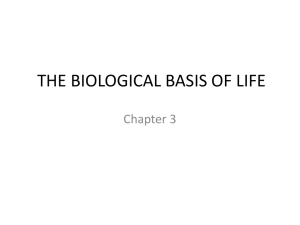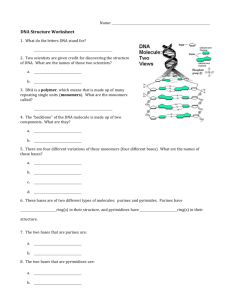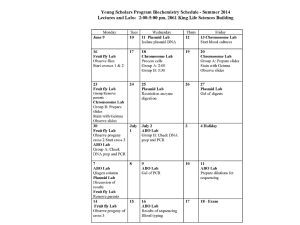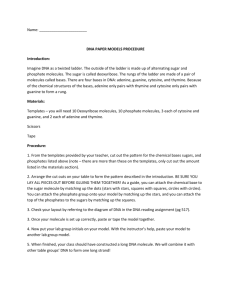Building the Twisted Molecule of Life: DNA Name Part A: Structure of
advertisement
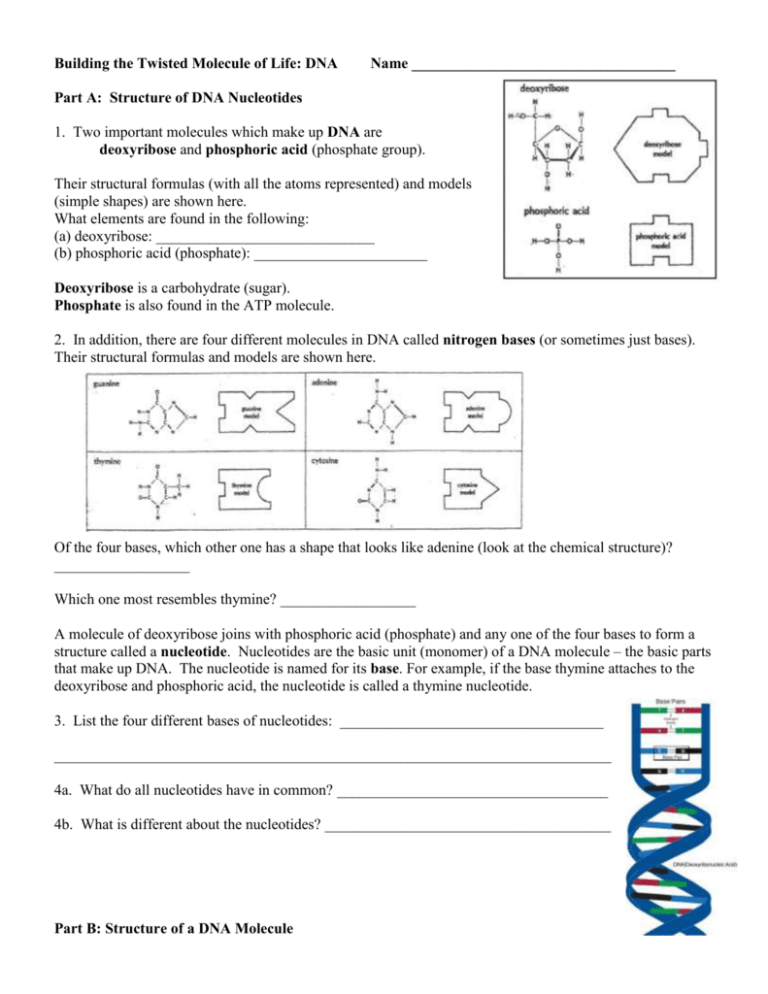
Building the Twisted Molecule of Life: DNA Name ___________________________________ Part A: Structure of DNA Nucleotides 1. Two important molecules which make up DNA are deoxyribose and phosphoric acid (phosphate group). Their structural formulas (with all the atoms represented) and models (simple shapes) are shown here. What elements are found in the following: (a) deoxyribose: _____________________________ (b) phosphoric acid (phosphate): _______________________ Deoxyribose is a carbohydrate (sugar). Phosphate is also found in the ATP molecule. 2. In addition, there are four different molecules in DNA called nitrogen bases (or sometimes just bases). Their structural formulas and models are shown here. Of the four bases, which other one has a shape that looks like adenine (look at the chemical structure)? __________________ Which one most resembles thymine? __________________ A molecule of deoxyribose joins with phosphoric acid (phosphate) and any one of the four bases to form a structure called a nucleotide. Nucleotides are the basic unit (monomer) of a DNA molecule – the basic parts that make up DNA. The nucleotide is named for its base. For example, if the base thymine attaches to the deoxyribose and phosphoric acid, the nucleotide is called a thymine nucleotide. 3. List the four different bases of nucleotides: ___________________________________ __________________________________________________________________________ 4a. What do all nucleotides have in common? ____________________________________ 4b. What is different about the nucleotides? ______________________________________ Part B: Structure of a DNA Molecule A DNA molecule is shaped like a ladder. Deoxyribose and phosphate molecules join to form the sides or uprights of the ladder. Base molecules join to form the rungs of the ladder. Using the nucleotide models provided, put six nucleotides together, in order, to form the following sequence from top to bottom: (to make one side of the DNA “ladderlike” molecule) Cytosine nucleotide Thymine nucleotide Guanine nucleotide Adenine nucleotide Guanine nucleotide Cytosine nucleotide Let this arrangement represent the left half of a DNA molecule. It shows one side plus six half rungs. 5. If DNA is like a ladder, which two molecules of the nucleotide form the sides of the ladder? __________________________ & _______________________ 6. To which other molecule of the nucleotide does the nitrogen base attach? _______________________ 7. Which molecules of the nucleotide form half of the ladder’s rungs? ________________________ Complete the right side of the DNA ladder by matching the bases of other nucleotides to form complete rungs. It will be necessary to turn molecules upside down in order to join the bases on the rungs. NOTE: The ends of each base will allow only a specifically shaped matching new base to fit exactly. 8. Why is the other side of the DNA “ladder” upside down? ____________________________________ Your completed model should look like a ladder with matched bases as the rungs. Besides being shaped like a ladder, a DNA molecule is twisted like a spiral staircase. However, your paper model cannot twist to show this. 9. Is the order of half-rung bases exactly the same from top to bottom on both sides of your model? _______ 10. Only two combinations of base pairings are possible for the rungs. Name these pairs. ___________________-___________________ & ___________________-___________________ 11. If four guanine nucleotides appear in a DNA model, how many cytosine nucleotides will there be? ____ 12 a. Your DNA model has four guanine nucleotides. Does the number of cytosine nucleotides in your model agree with your answer to #10? _______ 12b. The following are the bases on one side of a DNA molecule. List the bases that would make up the other side of the same DNA molecule. Thymine ___________________ Adenine ___________________ Guanine ___________________ Guanine ___________________ Cytosine ___________________ Part C: DNA Replication A chromosome contains DNA. Your DNA model represents only a short length of the DNA in a single chromosome. An entire chromosome has thousands of “rungs” (called base pairs) rather than only six. Although your model is only a small part of a chromosome, its replication is the same as that of an entire chromosome during mitosis and meiosis. Open your DNA model along the point of attachment between the base pairs and separate the two ladder halves. See the illustration as a guide. A real chromosome untwists and “unzips” in a similar way before replication. Using the left half of your model as a pattern, add new nucleotides to form a new right side. Build a second DNA model by adding new nucleotides to the old “right” half of the original model. 13. Do the two new DNA molecules contain the same number of rungs? ______ 14. Is the order from top to bottom of base pairs the same for both new molecules or different? ______ 15. How many adenine-thymine pairs are in each new DNA molecule? ___________ 16. Are they both the same? ________ 17. Are the two DNA molecules exact copies of each other? ____________ The specific order of bases in DNA serves as a code or language. When a chromosome replicates, the code (the order in which the bases occur) is carried over to the new chromosome.


